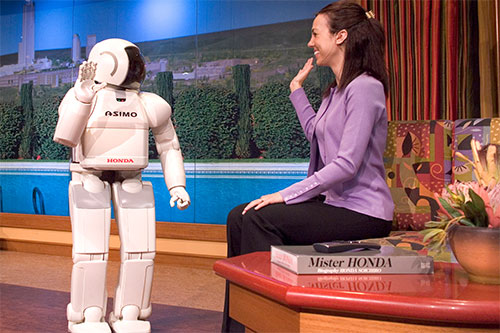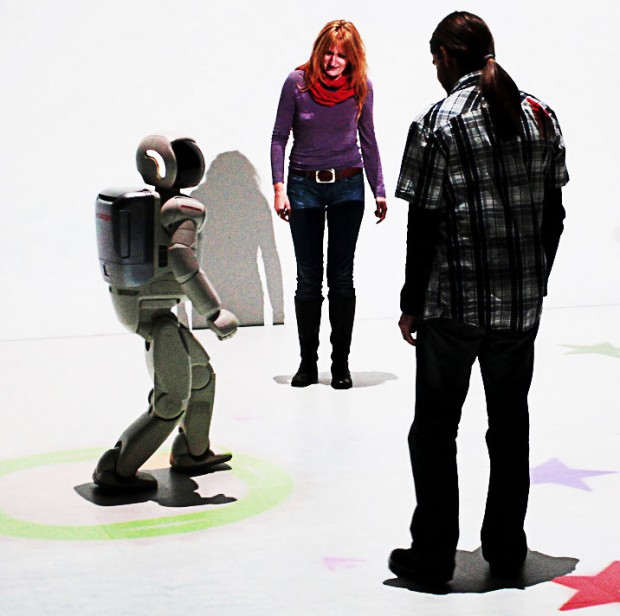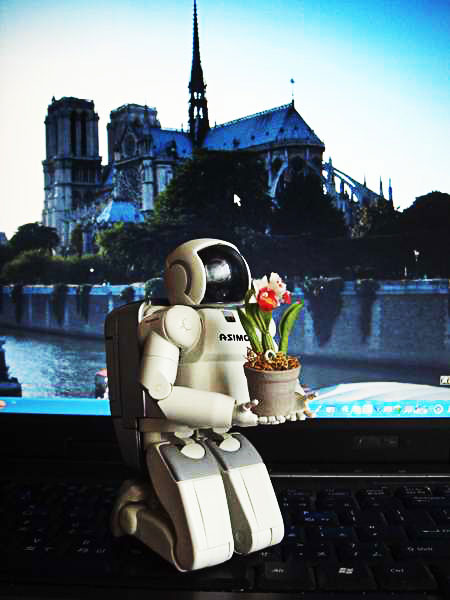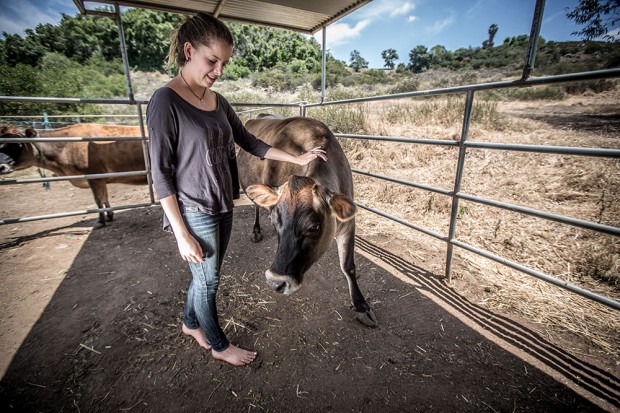08 July 2013 – Disappearance Day of Srila Bhaktivinoda Thakura
Lecture – BG 4.34 Krishna In Every Bush In Bulgaria – Video
→ Prahladananda Swami
Consciousness In a Simulated World
→ 16 ROUNDS to Samadhi magazine |
Living in our high-tech world, it seems today almost anything is possible. We are creating not only the new and improved, but are becoming exceptionally good at mimicking life itself. Many are familiar with our new digital friend “Siri,” and other similar examples of technology known as “artificial intelligence.”
However, I, like others, quickly found out the human-like “intelligence” of “Siri” is not at all the “intelligence” we’d like her to be. She is a nice gimmick at best. Users start to notice her limitations, once the seemingly witty remarks become noticeably redundant as she provides her often irrelevant pre-programmed answers. How many times did you shout “Dammit Siri!” as she again directed you to an old abandoned warehouse, instead of a supposedly existing gas station? Perhaps AI (artificial intelligence) is not what it is all cracked up to be. But, perhaps we haven’t yet seen its full potential?
THE WORLD’S MOST ADVANCED
Meet ASIMO, the world’s most advanced humanoid robot. Initially introduced way back in October of 2000 by Honda, ASIMO is a robot designed to be a multi-functional mobile assistant. ASIMO was designed with very advanced recognition technology, giving the robot the ability to move objects, exhibit various postures and gestures, and be aware of the surrounding environment. ASIMO can even recognize faces, even when ASIMO or the human being is moving. It can individually recognize approximately ten different faces. Once they are registered, it can address them by name and distinguish them by sound.
Many people at the exhibition are astounded upon first seeing a robot of this caliber. Many of the typical responses included things like:
“ASIMO’s capability is truly outstanding!” said one.
“Wow, it looked like someone was actually inside that thing,” said another.
One participant even stated, “I feel an emotional connection; I feel a kinship with Asimo and could easily see how a person could get attached.”
Many people there also stated that they felt a great sense of human accomplishment, in addition to the astonishment, and are happy that we, as a civilization, could create such a “life-like” piece of technology.
While ASIMO and others are already being prepared as personal assistants for home and commercial markets, many are asking a more philosophical question, which also happens to be the biggest question regarding AI. Will we ever be able to create a computer that will be truly conscious and self-aware?
HUMAN BRAIN: ANOTHER COMPUTER?
Since the rapid technological development of the 1980’s, many things are now possible. But, the question remains, can you have consciousness in a simulated program?
Actually, the same question comes up in the real world. In the real world you have molecules and different constituents of matter sitting together in different relationships. Many AI proponents argue that if you capture the different relationships that go into the brain, the process of thought occurring in the physical structure in the body, you capture the very essence of thoughts and self-cognizance, and can then produce a simulated conscious actor.
Is computer-simulated consciousness truly ‘alive’?
If you could capture inter-relationships and duplicate them in a computer, would the resulting model be self-aware? Right now I am writing and have a conscious perception of what is going on. You can imagine a robot speaking as I am, but there would be no actual consciousness, it would merely be a structure going through the programmed motions. Just because a computer program is simulating all the behaviors of a living conscious actor, it still is not enough to give the computer self-cognizance.
John Searle is an American philosopher and currently the Slusser Professor of Philosophy at the University of California, Berkeley. Among his notable concepts is the “Chinese room” argument against ”strong” artificial intelligence. Searle states: “Just because a computer program simulates all the different relationships that go into conscious thought that doesn’t mean it will be conscious like you or I.”
Because it is merely a program that is being executed, there is no actual conscious awareness on the computer’s part. But when it comes to studying the human brain, bio-chemists may argue that consciousness exists in the brain because of the presence of basic brain molecules, and that when you have specific combination of polypeptides in the brain, that combination will generate the conscious experience. And if you ask a bio-chemist, “What is it about these polypeptides that generate consciousness?” He will likely say that it is the structure and the relationship of its molecular components.
HOW REAL CONSCIOUSNESS WORKS WITHIN UN-REALITY
So, what you have in the human brain is a relationship between molecules, just as you have the relationship of electrical currents following the pattern of a computer program!
Other than sophistication, what is the real difference? There is none actually.
If the brain is merely a hyper-complex machine, then by the same logic, we must question as to when and where consciousness actually arises in the machine of the brain. Does this mean our personality is nothing more than an evolved computer simulation? It may be that modern computer science has handed us the answer to this question.
We have already seen a similar instance where a real conscious actor is existing and acting within a simulated program. It is known to those in the computer world as “virtual reality.” In a virtual reality environment there is consciousness because there is an actual human being who is experiencing the simulated world through the medium of a virtual reality interface, which in this case would be the hardware interface, i.e. the head gear and gloves that hook up to the computer to allow the participant to interact with the virtual world.
Although there is sentience within virtual reality because of the human participant, is the simulated world itself conscious without the conscious actor using the interface technology? The obvious answer would be no. The simulated world is only a show of movement as long as there is a real user present. Similarly, if our brain and body is merely another machine, then could it be that we are non-material conscious actors experiencing a simulated world through a more sophisticated type of virtual reality hook up, such as the human body and brain?
“The Prime Living Entity is situated in everyone’s heart and is directing the wanderings of all living entities, who are seated as on a machine, made of the material energy [the human body]” Bhagavad-gita 18.61.
In a virtual reality simulation, the participants are all linked in the simulated world with a technological sensory interface. In the ancient Indian Sanskrit texts, Vedic science informs us that in real life we are conscious, non-physical entities; yet, we are linked to this world through an external sensory interface of the subtle intellect, mind, and gross physical senses. In this way many parallels can be made with sankhya-yoga, a classic philosophical system of India.
In Sankhya yoga texts, this world is described as the world of maya or the “illusory” world. It is here that the “atma” or non-physical spirit soul accepts a material body, mind, and senses and partakes in a simulated identity in a continual evolution of life and death. In this way the soul is reincarnated through a variety of different species of life, each new life being a kind of simulated or virtual reality.
A computer simulated consciousness is in the realm of this maya, this illusory exhibition of consciousness arising solely from mechanical events. Although there is no conscious entity in a computer or robot, it seems that the robot is real and living, because of the apparent operation and behavior of the computer. In the same way, it only appears that the body is itself alive, with the chemicals in the brain enacting the conscious experience. Rather, the body is merely an instrument for an incorporeal, transcendental entity.
This is the beginning of all the spiritual understanding that has been discussed in the Vedic literature in the land of India and civilizations abroad for thousands of years; we are not our physical bodies, but rather spirit souls using bodies as temporary vehicles.
It may be that computer science is giving us clues to understand our reality and the true nature of consciousness, which has already been described so nicely in the advanced Sanskrit records of human wisdom. There is a real want for this scientific spiritual knowledge today, and the Bhagavad-gita and Srimad Bhagavatam are important works in the study of consciousness.
Read the Bhagavad-gita, Srimad Bhagavatam, and other preserved Sanskrit records at (QRC Link: http://vedabase.com)
The only end we would gain through this current technological showboating is that of an imitation. We can only imitate consciousness, and never create it, simply because of the fact that consciousness is not material.
Lecture – SB 1.3.43 Mudhas And Asuras – Video
→ Prahladananda Swami
Lecture – BG 6.25 Begins as Courting and Ends in Court – Video
→ Prahladananda Swami
Lecture – SB 1.5.32 Set Up Your Own Vaikuntha Planet – Video
→ Prahladananda Swami
Lecture – BG 13.30 Dynamics Of Doing – Video
→ Prahladananda Swami
Escondido Farmers
→ 16 ROUNDS to Samadhi magazine |
By the will of providence, for the last seven years I have been trusted with the service of president of a spiritual community. Two years ago our community was able to procure land suitable for farming. However, I am embarrassed to say, none of us knew much about farming. Our prayers were answered when we met Shawn and Susan, who are now running our farm.
Over the years, I learned that farming is an important step towards a more simple and natural life. Without a simple and natural life, spiritual life becomes difficult. My spiritual master instructed me to try as far as possible to adjust to a natural way of life, free from dependency on machines. He also said that we need not be against anything or for anything. We are simply interested in spiritual life and farming is an important step towards simplifying the complicated, modern civilization to allow for decent human and spiritual life.
THE FARMERS
Shawn and Susan have been married since 1994. They are both from Riverside, California, where they grew up and eventually met.
Shawn was born in 1969. He lived with monks in a monastery for a year, in 1993, at the ISKCON temple in Laguna Beach, CA. In 1999, Shawn and Susan moved, with their two daughters, to New Vrindavan, a rural community in West Virginia, where they stayed for one year. During this year Shawn and Susan were learning how to farm. Their teacher was a swami (!), Varshana Swami. The swami has been their spiritual guide and teacher from the early days of their spiritual interest. Since the beginning he was encouraging them to learn how to grow food.
First time Shawn grew plants was when he was a monk at the ISKCON Laguna Beach temple. (Correction: As a teenager, Shawn once grew a ganja plant, which should not come as a surprise to anyone living in California.)
Shawn says that his interest in farming certainly did not come from his family. He always felt farming is a most natural thing to do. By reading the books of his spiritual teacher’s teacher, Srila Prabhupada, he learned the importance of simple living in order to allow for higher or sophisticated thinking. The books taught him that buying food from corporations is neither necessary nor exactly natural.
For a few months in 1991, when he was 21, Shawn lived with Rastafarians at Trinidad, who grew their own food. That is where Shawn received his first book, The Science of Self Realization, by the author who was later going to profoundly influence his life – Srila Prabhupada.
Susan grew up on her family’s three-acre property in Riverside. She helped her parents with gardening. As a child, she had a pony for a pet…as well as ducks, chickens, bunnies, a cow, and you name it. On the property were also fruit orchards. That was her lifestyle growing up.
“Shawn and Susan now laugh about watching the TV series Little House On The Prairie as juveniles.”
Shawn and Susan now laugh about watching the TV series Little House On The Prairie as juveniles, but also recognize how it helped stir their interest in farming and living closer to nature.
Shawn and Susan have always been looking to find ways to farm in Southern California. When asked to help get an organic farm going, they saw it as an opportunity to make their dreams come true.
Now they are happy managing a farm in Escondido. However, this move involved taking some risks. They left a large and comfy house in Riverside, in exchange for a shabby structure in Escondido, which they eventually, little by little, renovated. They left their connections to the network of people that was their economic base, including job opportunities. Their kids left their friends who they grew up and went to school with. That was pretty difficult for them.
Living in a farm setting with animals and plants in nature is sattvic and allows for development of deeper interpersonal relationships with the surrounding environment. Shawn considers farming as a participation in the natural cycle of biological existence, which ultimately brings them closer to their deepest and truest self, the soul and God.
Living on a farm makes it easer to cultivate one’s spiritual life and spare one’s children the gross materialistic influences, which are otherwise very common in the modern “Babylons.”
To keep a job in the corporate environment so that a few can hoard gold, or whatever the standard of money might be, does not work for Shawn and Susan. Even though simple farm life can at times be physically demanding, they are happy to pay that price in exchange for freedom, at least relative freedom, from the tight grip of the cruel and unnatural, vicious corporate cycle.
“Buying food from corporations is neither necessary nor exactly natural.”
Producing one’s own food is additionally challenging in the industrial economic system, which does not support that kind of independency, which rather favors industrial farming, a demonic perverted reflection of what is supposed to be the most natural lifestyle. The cost of city water is especially challenging, but Shawn and Susan hope to dig their own well soon. Experiencing just mentioned challenges, many aspiring farmers are forced to take out loans to get their farms off the ground; but, then they find themselves in debt and forced to be profitable in terms of the modern commercial society; thus defeating the essential purpose of farming.
When farming is done for the sake of integration into the natural cycle of life, it is healing both spiritually and physically. Furthermore, to be able to work from home is ideal, as opposed to daily commuting, which creates numerous difficulties.
Now Shawn and Susan’s son is twelve and the two daughters are fifteen and seventeen. The parents had hoped to migrate onto a farm when their children were younger, but an opportunity didn’t arise until now. Nevertheless their children have integrated into farm life remarkably well. Their daughter recently wrote a school paper on the topic of danger of genetically modified seeds, a paper that was based on a workshop that Shawn and Susan taught at the farm.
This spring, Shawn taught a seven part workshop, teaching people how to grow food. Students learned composting, soil preparation, planting, harvesting, and even the yogi way of offering produce to God. The workshop was free, while most attendees gave donations to support the farm project. Next workshop will be taught in the fall and the reader is invited to attend.
Shawn and Susan’s work on the farm is a service to humanity in general and the International Society for Krishna Consciousness (ISKCON) in particular. They consider this service so important that they don’t mind the lack of pay. For their financial needs, they do extra work outside of the farm project. Shawn is an excellent handyman. The produce from the farm is distributed to two ISKCON temples, Laguna Beach and San Diego. However, since the amount of produce grown on the farm exponentially increases, very soon Shawn and Susan will be able to sell enough of it to cover their needs. “After all, that is self-sufficiency,” says Susan.
On the farm’s four acres grows a large variety of vegetables alongside recently planted fruit trees. When growing such a wide variety of produce, unlike in commercial farming where cultures are planted uniformly, there is no need for use of pesticides, insecticides, and herbicides (read poison). This appears like a natural lesson which teaches us that serial production of any kind is not desirable.
Use of insecticides gets rid of all the insects. But a farmer should not want to get rid of all the insects; some insects are good because they eat the “bad” insects. Susan remembers when their produce was being attacked by aphids, and how all of a sudden millions of ladybugs came and ate all the aphids. One reason why Shawn and Susan plant flowers is because flowers attract bees, which help pollinate the summer squashes. Nature is truly one big cycle. There is no need to use poison. (Especially not the one produced by giant corporations such as Monsanto.)
KYLE
Kyle is 26 and is living on the farm, helping Shawn and Susan. Kyle was born and grew up in Orange County in an upper-middle class family. Having given up his $100,000.00-a-year job with an electrical company, Kyle now lives in a trailer on the farm. He actually sleeps outside, not in the trailer. Sometimes he crashes in a hammock and sometimes in a tent. He likes to see the stars at night when going to bed.
Kyle was pursuing a degree in environmental sustainability, but now he is finding practical farming to be more important. Besides, why spend up to $100,000.00 to get a degree from a group of people who are trying to monopolize education and institute a system of indentured servitude? Education is, after all, about getting educated rather than receiving a diploma. In many traditional societies, if you wanted to learn an art, you went to someone who knew how to do it and became their apprentice. The teacher would thus be grateful for the apprentice’s help, would transfer the knowledge to the apprentice, and would even pay him.
Payment of credit card debts, mortgage debts, etc., can be evaded by filing bankruptcy and other such methods. However, the student loan seems to be the only debt one cannot get rid of. Chanakya, a royal advisor who lived a few hundred years before the Common Era, said that disease, fire, and debt need to be dealt with immediately, as their presence reduces one’s life span. What, then, to say about the modern system where almost everyone lives most of their life in debt?
Kyle’s long term plan is to center his life on farming.
THE FUN DAY
The fun day on the farm is usually Tuesday when the monks come from the San Diego temple. It is a full day of communal farm work, which also includes a farm fresh midday lunch, and chanting in kirtana – the week’s highlight.
A special event occurs twice a month, every other Saturday, when Shawn and Susan host a sat-sanga, a home gathering of spiritual aspirants and savants. The reader is invited.
For info regarding the courses, donations, home gatherings, or anything else related to the farm, feel free to contact Shawn at ahringhoff1169@gmail.com.
I graduated from school! Now what?
→ 16 ROUNDS to Samadhi magazine |
Choosing a career path, or a job, can be a difficult and overwhelming task. In our modern American culture, the challenge begins during the school years; as in the American public school system, children and teens are expected to learn the same academic standards, regardless of their future work goals. Students who have less academic and more technical talents may experience frustration from the academic pressures of school. College is also an expected path for many students in America. One selects a major of interest, and while sometimes this major can lead to a practical career, other times it does not, and one graduates wondering, what next? Sometimes one graduates and struggles to get any job simply to pay the bills, rather than selecting a job relevant to one’s studies. The period after graduation can become a confusing although exciting time.
Other countries and cultures have different systems of education. In Germany for example, there are three different educational roads, and the path is chosen when the child is around age 11, based on his/her interests, academic skills, and natural abilities (it is not set in stone however, and can be altered later). One option is the university path for future scholars, researchers, professors, etc., whereas the other two options end earlier (around tenth grade) and prepare students to enter technical or vocational schools, or apprenticeships to become, for example, a nurse, carpenter, or other specific trade. It is recognized in such an educational system that not everyone needs to focus strictly on academics to achieve success, but can start training for a practical career earlier in life.
Ayurvedic philosophy and traditional Indian culture in general, similarly recognize that each person has a unique dharma, or calling in life, and that strict academia is not necessary for everyone. One chooses a career and education based on one’s dharma (doing what comes naturally). According to this system called varnashrama dharma, there are four general categories of varna, or work. First are the brahmanas who are intellectuals, priests, teachers, and academically inclined folks. They are considered the head of society, as they can offer wisdom and guidance for others’ wellbeing. Next are the ksatriyas who offer protection and security, keeping law and order, and are akin to the arms of society. The vaisyas are the farmers and businesspeople. They grow food which we need for survival, and conduct other forms of business, and are the stomach of society. The sudras are the legs of society. They assist and offer manual labor for the other three classes. All four varnas are equally important for the functioning of society, just as a human body functions best with a head, arms, stomach, and legs. Varnasrama dharma is not a caste system in which one is born into a profession, or in which the sudras are treated poorly and the brahmanas treated with respect. Rather, varnasrama dharma recognizes individual differences in people’s strengths and skills, and offers a path for each person, with all working cooperatively for the smooth functioning of society. According to this system, like the one in Germany, not everyone is expected to follow a strict university/academic path. Rather, each student is to be trained in a path that is well suited for his/her future goals.
Although our public education system encourages more of the one size fits all approach, we can still make ourselves aware of the concept of dharma when choosing our career path (whether immediately after graduation or later in life). Dharma involves choosing a career based on your genuine calling in life, rather than giving into society’s subtle messages that we are to choose the job with the most money or best benefits. The word vocation comes from the latin root “vocatio” which literally means a calling. A job need not be something you simply do from 9-5 so you can come home, pay your rent, and enjoy some food and a few hours of relaxation or entertainment after a long day. People who have jobs that are just “to pay the rent” are often looking forward to Friday and regretting Mondays. This is not how life has to be! If you find yourself suffering through each work week, perhaps you have chosen a job that is just a job, rather than a vocation. Each of you, yes even you, has a unique talent, skill, or purpose that can be used to offer service to others while earning you a living that you truly enjoy. A vocation is a place of happiness, not just a place to get a paycheck.
How do you know what your vocation or dharma is? A vocation is that which you love to do. You feel like your genuine self when doing it, and are not looking at the clock waiting for the day to end. Deep down, you know what it is. It may take some courage, it may take some breaking out of the comfort zone, it may carry a reduction of salary, but everyone can work a vocation instead of a job. If doing so would lead to a reduction of salary, one must ask, does earning more money actually make me happy? We have all heard stories of people who were earning more money than they ever thought possible, but were not necessarily happy. I met one such lady who quit her high paying job and followed the path she genuinely wanted to follow, and is now more satisfied. If your dharma involves earning large amount of money, that is fine. The point is not to put down riches themselves, but to emphasize that riches alone, at the expense of following your true path, is not enough to bring satisfaction. If you spend 40 hours a week doing something, that something should be meaningful to you.
Whether you have recently graduated from school, or are contemplating a career change, I encourage you to ask yourself, what is my vocation, or dharma, rather than what job is easy to get and will pay my bills? Just think – if we were born to do something, won’t our basic needs be provided for if we do that which we are truly meant to do? It is a matter of faith, but talk with those who have taken that leap of faith and chosen the road of vocation and you will see the results for yourself. Choose Dharma, choose happiness!
Class & Kirtans by HH Radhanath Swami
→ Gouranga TV - The Hare Krishna video collection
Class & Kirtans by HH Radhanath Swami
Model of Main Altar
- TOVP.org
Our head of Research and Development, Parvata Muni Das, has been steadily working in his workshop for the past several months.
His project? A small scale model of the TOVP. His current focus is building a model of the main altar. The purpose of this time-consuming endeavor is to give the art department a visual aid by which to understand the placement of the main altar in the temple room. Variables that can be viewed and adjusted include the position of the deities, the distance between the pilgrims and the deities and the actual position of the altar in relation to the design of the temple room.
Capturing the intricacies of the altar design as well as translating the actual proportions into a small scale model require dedication and focus. Parvata Muni Das has brought his years of experience and qualifications to this strategic occupation. The staff at the TOVP are grateful to have him and his talents.
Lecture – CC Adi 1.047 Looking For The Honey – Video
→ Prahladananda Swami
Lecture – SB 4.18.23-26 Rock Music In Hell – Video
→ Prahladananda Swami
Is he a kind man?
→ Servant of the Servant
Krishna consciousness, however fully spiritual, is a personal philosophy which means it is all about loving relationships. Kindness is the beginning of love and Srila Prabhupada was hard as thunder and soft as a rose with his disciples and both characteristics was a display of his compassion.
The colleague of mine like everyone in this world has a material understanding of love and kindness which pertains solely to the body&mind and hence would not understand such transcendental expressions of kindness and love.
Below is a video that depicts his loving relationship with his disciple that is purely on the spiritual plane.
Hare Krishna
Is he a kind man?
→ Servant of the Servant
Krishna consciousness, however fully spiritual, is a personal philosophy which means it is all about loving relationships. Kindness is the beginning of love and Srila Prabhupada was hard as thunder and soft as a rose with his disciples and both characteristics was a display of his compassion.
The colleague of mine like everyone in this world has a material understanding of love and kindness which pertains solely to the body&mind and hence would not understand such transcendental expressions of kindness and love.
Below is a video that depicts his loving relationship with his disciple that is purely on the spiritual plane.
Hare Krishna
TEXAS FAITH 105: Was it moral to shut down the Texas Senate?
→ Nityananda Chandra Das' Blog, ISKCON Dallas
 Dallas Morning News,
Dallas Morning News,
Each week we will post a question to a panel of about two dozen clergy, laity and theologians, all of whom are based in Texas or are from Texas. They will chime in with their responses to the question of the week. And you, readers, will be able to respond to their answers through the comment box.
Last week’s week’s filibuster in the Texas Senate stopped an abortion bill and catapulted Sen. Wendy Davis to national political attention. Television stories beamed pictures of hundreds of cheering, jeering protesters who shut down Senate business while Republican leaders struggled to regain control. In the end, the bill that would ban abortions after 20 weeks of pregnancy failed and Gov. Rick Perry called the Legislature back into another special session on Monday.
The protesters – criticized as a mob by some and hailed as heroes by others – were very much a part of the story, if only because it’s rare democratic institutions in this country are brought to a halt by people chanting from the balcony in a legislative chamber. The episode has been the focus of heated debate in terms of politics and ideology. Set aside which side you’re on. What if the roles were reversed. When is it ethical and moral to shut down a institution of government?
The question: Was it moral to shut down the Senate? Not whether it was politically successful or tactically expedient or even whether your side prevailed or not, but was it moral?
NITYANANDA CHANDRA DAS, minister of ISKCON (International Society for Krishna Consciousness), Dallas
First of all, it needs to be pointed out that morality is a metaphysical concept. Morality cannot be established by science.
On the relative platform there was no moral issue with citizens using deceptive means when they are ruled by a deceptive government. It would not be the same if modern government were led by those who are not self interested.
On the absolute platform there would be a moral issue of disturbing government processes. Provided that government actually worked for the metaphysical rights of all of living beings without prejudice. Whether they are Black, White, animal, or even in the fetus stage. But that is not the case.
The metaphysical notion of morality can only be fully established when one understands the metaphysical. As long as one cannot see the soul there will be victims. Because of seeing African Americans as soulless beings we had slavery. Because seeing women as half souled beings we have exploitation. Because of seeing animals as soulless beings we have billions unnecessarily painfully slaughtered. And because of seeing the helpless unborn children as soulless beings their own mothers are being endorsed for murder.
To see all responses of the TEXAS Faith panel click here.
TEXAS FAITH 105: Was it moral to shut down the Texas Senate?
→ Nityananda Chandra Das' Blog, ISKCON Dallas
 Dallas Morning News,
Dallas Morning News,
Each week we will post a question to a panel of about two dozen clergy, laity and theologians, all of whom are based in Texas or are from Texas. They will chime in with their responses to the question of the week. And you, readers, will be able to respond to their answers through the comment box.
Last week’s week’s filibuster in the Texas Senate stopped an abortion bill and catapulted Sen. Wendy Davis to national political attention. Television stories beamed pictures of hundreds of cheering, jeering protesters who shut down Senate business while Republican leaders struggled to regain control. In the end, the bill that would ban abortions after 20 weeks of pregnancy failed and Gov. Rick Perry called the Legislature back into another special session on Monday.
The protesters – criticized as a mob by some and hailed as heroes by others – were very much a part of the story, if only because it’s rare democratic institutions in this country are brought to a halt by people chanting from the balcony in a legislative chamber. The episode has been the focus of heated debate in terms of politics and ideology. Set aside which side you’re on. What if the roles were reversed. When is it ethical and moral to shut down a institution of government?
The question: Was it moral to shut down the Senate? Not whether it was politically successful or tactically expedient or even whether your side prevailed or not, but was it moral?
NITYANANDA CHANDRA DAS, minister of ISKCON (International Society for Krishna Consciousness), Dallas
First of all, it needs to be pointed out that morality is a metaphysical concept. Morality cannot be established by science.
On the relative platform there was no moral issue with citizens using deceptive means when they are ruled by a deceptive government. It would not be the same if modern government were led by those who are not self interested.
On the absolute platform there would be a moral issue of disturbing government processes. Provided that government actually worked for the metaphysical rights of all of living beings without prejudice. Whether they are Black, White, animal, or even in the fetus stage. But that is not the case.
The metaphysical notion of morality can only be fully established when one understands the metaphysical. As long as one cannot see the soul there will be victims. Because of seeing African Americans as soulless beings we had slavery. Because seeing women as half souled beings we have exploitation. Because of seeing animals as soulless beings we have billions unnecessarily painfully slaughtered. And because of seeing the helpless unborn children as soulless beings their own mothers are being endorsed for murder.
To see all responses of the TEXAS Faith panel click here.
Cow Protection Activities
→ Life With the Cows and Land
Cow Protection Activities
→ Life With the Cows and Land
We Don’t Need To Be In A Hurry
→ Japa Group

Today I was thinking of these words of wisdom. We don't need to be in a hurry to chant our Japa, we just need to concentrate and steadily chant with determination and conviction to get back to Godhead. Don't be like the rabbit and race ahead to the end of your 16 rounds....relish the Holy names as you would relish delicious prasadam.
We Don’t Need To Be In A Hurry
→ Japa Group

Today I was thinking of these words of wisdom. We don't need to be in a hurry to chant our Japa, we just need to concentrate and steadily chant with determination and conviction to get back to Godhead. Don't be like the rabbit and race ahead to the end of your 16 rounds....relish the Holy names as you would relish delicious prasadam.
Dance for the pleasure of The Avatars of Vishnu
→ The Vaishnava Voice
Although I am from England and grew up as a Christian, I was always interested in Vishnu. When I became a Vaishnava I learned more about Vishnu from the scriptures. I have also raised my children on the same path. Here is a dramatic dance by my daughters Jahnavi and Tulasi, with Jaya Krishna Das. It describes the avatars of Lord Vishnu according to the early mediaeval song written by Jayadeva Goswami. You will hear me singing the song in the background.
Shanti and Mani say that they have been connected with ISKCON for 15 years and although not initiated, they follow all the rules. Do they continue to make advancement in this way?
→ SivaramaSwami.com
ISKCON Management Sucks (a thought)
→ simple thoughts
One of the continuing questions I am asked is simple in form but poses the most difficult in answering as there is firstly a need to understand why the conclusion is met. It is a question I’ve been asked by both initiated and uninitiated devotees and although the wording is slightly different the thrust of it remains the same: I have faith in the chanting of the holy names of Krishna, I have faith in the Guru’s; But and for some it’s a Big But I don’t have faith in ISKCON Management.
Indeed sometimes I have empathy for what follows; sometimes it’s a clash of personalities or a long standing issue with people in authority (the guru’s visit is usually very brief and so some detachment is their). Other times it’s more deeper than this and in one way or another feel miss treated or that their appears to be a mismatch between the philosophy and it’s practice.
Personally I see how this can become a huge stumbling block, when we see that we teach honesty and then when faced with being asked to be dishonest in the legal system even when there is written and e-mail evidence not even a reprimand is given; OK so dishonesty is expected in this age of kali and we could ourselves apply a little logic and continue in service little disturbed. We can cheat and hub-wink management by skilful words but ultimately we are answerable to Krishna and if we cheat and become dishonest then we can cheat individuals even management but not Krishna.
But when injustice is done or if there is a perceived injustice the mind takes over, the logic boards switch off and like a cancer as word spreads from one to another so resentment grows and at the extreme ridicule and a withdrawal of association (either temporary or permanent).
This however is not unusual we are in the age of quarrel and after all it’s easy to manage without being in the position of management whilst it’s harder to manage when actually in that position of management; we can if our words are to be believed much better at the job than those doing it up to the point where were appointed to the post.
So am I surprised that this is a continuing and ongoing question?
Well NO.
My answer remains the same, continue to chant and follow the regulative principles and absorb oneself in service and leave the management politics to the management; after all ultimately we are answerable to Krishna not for others actions but our own.
It’s a point I have to constantly remind my mind of but out of interest and to explore more fully what are your thoughts on this question?
And here is an interesting quote to ponder closely:
If your preaching work is strong, then your management of temple affairs will also become automatically very strong. Just like if the head wills it, the hand will move. Preaching is like the head of our Krishna consciousness Society – if the head is removed, the whole body dies. Managing is the hands, which work nicely if the head is healthy. If the hands are removed, the body will not die, but it will be crippled. So preaching is more important than management, but both must be there if the whole body is to operate nicely.
- Srila Prabhupada
315. ponderji : my art work
→ 9 Days, 8 Nights
I have been working on this character lately who thinks a lot about life. Eventually, they make their way onto a T-shirt which you can buy ; ) Click the image and it will take you to the rest of the collection. Simple efforts from me and hope you will like it.
http://www.redbubble.com/people/ponderji
2013 06 27 Srimad Bhagavatam 10 21 16 Inherent Quality of Krishna is his all Attractiveness
→ Gouranga TV - The Hare Krishna video collection
2013 06 27 Srimad Bhagavatam 10 21 16 Inherent Quality of Krishna is his all Attractiveness
Yes, God does play Chess
→ ISKCON Malaysia
BY GOLOKA CANDRA DASA
KUALA LUMPUR - Clueless people often ask the question: "Does God exist?". Count befuddled scientists too in this category. On the other hand, smart people ask the smart question: "Does God play chess?"
The second question already accepts by implication the existence of God (or Supreme Intelligence, as Albert Einstein would put it). The questioner, especially if he happens to be working in the field of artificial intelligence, is more interested to learn about the thinking processes that a supremely intelligent being would utilise to solve the complex situations arising on the chessboard that are generally beyond the calculation of ordinary mortals. The objective of the questioner is to harness the same thinking processes to solve other problems in the real world.
Ever since the birth of computers, chess has been used as a yardstick to measure progress in artificial intelligence. One indicator of such progress is the regular "Man versus Machine" matches. In the beginning of the computing age (the good old days), human champions used to trash the machines. Today computers would trash 99.99% of the human race and hold the edge against even the best human players.
It has long been the Holy Grail for researchers and computer programmers in the realm of artificial intelligence to write a program that would enable a computer to play chess perfectly, without error or inaccuracy. As perfectly as God would, should He be so inclined to play the game.
Thankfully for chess enthusiasts, modern science is way behind in its quest to fully understand the game and crack the chess riddle once and for all, and thus render the game obsolette. In fact, I doubt that we would ever see the day when computers would be able to play chess perfectly, even if the best of their breed are quite impossible to be beaten by any human player today.
Now returning to the original question as to whether God plays chess, the affirmative answer is found in the Vedic scriptures. In the Mahabharata and the Shrimad Bhagavatam, there are references attesting to the chess-playing pastimes of the Supreme Lord Sri Krishna with His royal consorts in Dvaraka.
Even during His childhood frolics with the cowherd boys and girls in the forests of Vrindavana, the Lord is fond of playing chess. His Divine Grace AC Bhaktivedanta Swami Srila Prabhupada, founder-acharya of the International Society for Krishna Consciousness, writes thus in the "Nectar of Devotion" Chapter 42:
"...Krishna played with His intimate friends sometimes by fighting or wrestling with their arms, sometimes by playing ball and sometimes by playing chess."
So yes, God (addressed as Sri Krishna in the Sanskrit texts) does play chess. But if anybody out there is harbouring any delusions of challenging God to a match, be forewarned though that He is very selective about who He chooses to play with.
First you have to make a lot of spiritual advancement to qualify yourself to see God, before you can even think of playing with Him. According to the Vedic scriptures, only a spiritually elevated person will be able to see God face-to-face (let alone play chess with Him).
Amazing as it may seem, there were some exceptional mortals, even in comparatively recent history, whom God actually chose to play chess with. As the following history reveals.
Mathematicians and scientists love to quote this story (in some form or other) to explain mathematical concepts related herein, for example, exponential progression and binary numbers. Even the downright atheistic and those with little faith in God, love to quote this fascinating chess-playing pastime of God in order to explain mathematical ideas. You too will be similarly fascinated after you read our narration below.
In a small town called Ambalappuzha in Alappuzha district of Kerala state in South India, there is a famous ancient temple of the Supreme Lord Sri Krishna. This temple is believed to have been built more than a thousand years ago by a local king named Chembakasserry Pooradam Thirunal-Devanarayanan Thampuran.
This temple has a historic link with the renowned Guruvayur temple. When Tipu Sultan plundered the region in 1789, the Sri Krishna deity (Sri Guruvayurappan) from Guruvayur was safely brought to the Ambalappuzha temple and sheltered there in a special shrine that is now called Guruvayur Ambalam.
The temple attracts many visitors and tourists and its popularity is attributed to the nectarean quality of the paal payasam served there daily to all pilgrims. It is said that even Sri Guruvayurappan daily visits this temple (where He once resided) just to relish the paal payasam.
Paal payasam is a rich desert made of milk, rice and jaggery and is generally served during special occasions and festivals only. In particular, on the solar New Year day in mid-April when the Sun completes a full revolution and returns to the first sign of Mesha (Aries) on the sidereal zodiac. This solar New Year Day is celebrated throughout India and the surrounding countries in some form or other, in accordance with local customs. In Kerala state, it is called Vishu and paal payasam is prepared in all households for this special occasion.
However the daily tradition of serving paal payasam has been going at the Ambalappuzha temple for centuries as a direct result of a chess-playing pastime of the temple's presiding deity, Lord Sri Krishna. The game of chess was then known as chaturanga, the ancient and more complex version compared to the modern game.
Sri Krishna desired that paal payasam be served to the pilgrims at the Ambalappuzha temple DAILY, and not just on major festival days. But who would sponsor such an undertaking?
As is generally the case, the temple administration is under the jurisdiction of the local king, who also happened to be a great devotee of the Lord as well as a champion chess player. So the Lord assumed the form of a brahmana sage and appeared before the king in his royal court, and challenged him to a chess match.
Since chess is a military-themed strategy game, it was generally played by the kings and kshatriyas (military class) of the time. They would also play for high stakes. When the king inquired what the stake would be, the brahmana answered: "Rice grains", and stipulated that the number should correspond to the squares of the chessboard -- one grain for the first square, two grains for the second square, four grains for the third square and so forth, each square doubling up on the previous, until all the squares on the chessboard are covered.
The king was puzzled by the brahmana's strange request which seemed paltry to him. But as a king, he was bound by the kshatriya (military) code of honour to accept a challenge to combat or competition. So he agreed to the brahmana's proposal.
The chess match started. The king, though a very experienced and competent player, was inevitably outplayed by the divine sage who won the match. The magnanimous king offered to gift gold and other valuables to the brahmana for his victory. But the brahmana stuck to his guns and insisted that the king pay him just the rice grains that they had played for.
The king called for a sack of rice. His servants started piling the rice grains according to the stipulated formula corresponding to the squares on the chessboard: 1, 2, 4, 8, 16, 32, 64, 128, 256, 512, 1024 grains...
Immediately the king realised what the divine sage had known all along, that the numbers would explode exponentially to impossible magnitudes soon. By the 20th square, the number of grains would exceed one million. By the 40th square, the number would exceed a trillion.
The king realised that this rate of progression would soon empty all his royal granaries. Nay, even all the rice in the world would not be sufficient to fulfill his debt to the brahmana.
To give an idea of the astronomical size of the numbers generated by the pre-agreed rules of this chess match, the total number of rice grains that would correspond to a 64-squared (8 x 8) chessboard is 2 ^ 64 - 1 which is exactly 18446744073709551615.
In approximate terms, this is about 10 ^ 18 * 18, or 18 billion billion rice grains. It is estimated that this number would cover the land surface area of modern India seven feet high in rice grains.
The king, as the chief enforcer of the laws of the land, knew well the penalty generally imposed on a person who defaults on his debt -- that he would lose all his material possessions to his creditor. Now he was honour-bound to adhere to the same principle that he enforced.
Although the honourable king was prepared to accept the imminent loss of his wealth and kingdom, still he was feeling very wretched and helpless over being unable to keep his plighted word to the brahmana. The king gazed at the divine personality before him and wondered who is this extraordinary person who had outplayed him and what is his purpose.
Lord Krishna, seeing the king in his predicament, revealed His true form to His dear devotee and gave him a reprieve -- that he need not pay his debt on the spot, but that it can be paid by daily instalments.
Lord Krishna ordered that the king and his descendants should prepare and serve paal payasam (sweet rice cooked with milk and jaggery) at the Ambalappuzha temple every day until such time that the rice grain debt is repaid fully (in the form of paal payasam).
So this in short is the fascinating history of the Ambalappuzha temple and how its long-established tradition of offering paal payasam daily to the presiding deity and then distributing it as prashadam (food sanctified by offering to the Lord) to the pilgrims originated from a historic chess match between Lord Krishna and the king.
Festival of India at Yonge-Dundas Square
→ The Toronto Hare Krishna Blog!
 Can’t wait for Festival of India (Ratha-Yatra) on July 13-14th? No problem! Come and join us for the Festival of India launch party on Yonge-Dundas Square. The pre-festival is held on July 6th 2013, one week before the Festival of India itself.
Can’t wait for Festival of India (Ratha-Yatra) on July 13-14th? No problem! Come and join us for the Festival of India launch party on Yonge-Dundas Square. The pre-festival is held on July 6th 2013, one week before the Festival of India itself.A can’t-miss event in its own right, the Yonge-Dundas Square Festival of India Launch Party features a cavalcade of activities, attractions and performances, including a South Asian bazaar, traditional delicacies and foodstuffs, henna tattoos, face-painting, dress-in-a-sari booths, and more! Don’t forget to stop by our live art exhibit and vegetarian cooking demonstrations happening throughout the day. Yoga enthusiasts will be intrigued to discover that the event also features outdoor yoga classes given by Toronto’s prominent studios. Last year was a huge success with three packed classes, attended by regular yogis and people passing by!
Be sure to hang around towards the evening to participate in the climax of the day’s celebrations- kirtan with Madhava and many more renowned kirtaneers! Beginnning at 6 pm, the kirtan promises to transform the heart of downtown Toronto into a sublime experience! The ancient mantras (kirtan) from east will reverberate and grace the grit and steel of our downtown metropolis. With renowned singers from around the world, it can only be described as a ‘kirtan explosion’ that will certainly shake Toronto!
Everyone’s invited to come taste and participate in the mystic exoticism of the 41th Annual Festival of India at Yonge-Dundas Square.
Festival of India at Yonge-Dundas Square
→ The Toronto Hare Krishna Blog!
 Can’t wait for Festival of India (Ratha-Yatra) on July 13-14th? No problem! Come and join us for the Festival of India launch party on Yonge-Dundas Square. The pre-festival is held on July 6th 2013, one week before the Festival of India itself.
Can’t wait for Festival of India (Ratha-Yatra) on July 13-14th? No problem! Come and join us for the Festival of India launch party on Yonge-Dundas Square. The pre-festival is held on July 6th 2013, one week before the Festival of India itself.A can’t-miss event in its own right, the Yonge-Dundas Square Festival of India Launch Party features a cavalcade of activities, attractions and performances, including a South Asian bazaar, traditional delicacies and foodstuffs, henna tattoos, face-painting, dress-in-a-sari booths, and more! Don’t forget to stop by our live art exhibit and vegetarian cooking demonstrations happening throughout the day. Yoga enthusiasts will be intrigued to discover that the event also features outdoor yoga classes given by Toronto’s prominent studios. Last year was a huge success with three packed classes, attended by regular yogis and people passing by!
Be sure to hang around towards the evening to participate in the climax of the day’s celebrations- kirtan with Madhava and many more renowned kirtaneers! Beginnning at 6 pm, the kirtan promises to transform the heart of downtown Toronto into a sublime experience! The ancient mantras (kirtan) from east will reverberate and grace the grit and steel of our downtown metropolis. With renowned singers from around the world, it can only be described as a ‘kirtan explosion’ that will certainly shake Toronto!
Everyone’s invited to come taste and participate in the mystic exoticism of the 41th Annual Festival of India at Yonge-Dundas Square.
How the Universe Became the Universe (Vedic Proto-Evolution)
→ Bhagavatam By Braja
Here is a summary of the main subject of Chapter 5 of Canto 2.
How the Universe Became the Universe (Vedic Proto-Evolution).
via How the Universe Became the Universe (Vedic Proto-Evolution).
How the Universe Became the Universe (Vedic Proto-Evolution)
→ The Enquirer
The Vedic view on primordial evolution (as for example expressed in Bhāgavata Purana, 2.5) is that time enters the material energy (which itself is a threefold energy reflecting the original threefold energy of Godhead). When time enters, things can proceed, things can evolve. The force driving the evolution is the svabhāva, which is the psychological disposition of the living entities who wish to project themselves into that material energy. This interaction between svabhāva and the tri-guṇa (threefold material energy) causes the universe to acquire a primordial collective destiny (karma) - which I conceptualize as a “DNA code” for the entire universe.
All this happens, by the way, before creation – while the universe is lying as a “bubble” in the “ocean of causality” aka “ocean of possibility.”
This primordial evolutionary state of the universe is ahaṁkāra - the primeval, collective universal sense that “I will act, I will accomplish my desires.” See, the catalyst of evolution was svabhāva, which is composed of desire. So when it progresses slightly in evolution it becomes the sense that “I can accomplish my desire.”
The three guṇa then interact with that ahaṁkāra and evolution continues by producing three primordial powers: the power to create material (dravya-śakti, created by tamo-guṇa), the power to perceive material (jñāna-śakti, created by sattva-guṇa), and the power to manipulate and interact with material (kriyā-śakti, created by rajo-guṇa).
Each power then evolves along its own line. This evolution is interconnected: Each material that evolves produces a sense object, which requires the evolution of a specific perceptual power, and a specific power of manipulation.
Dravya-śakti (the power to create material) eventually evolves into the primordial template of all perceivable objects. First it evolves into space – which is not just the stuff astronauts walk around in, it literally means space, like, “Hey, give me some space, buddy.” Space is the stuff that everything else fits inside. So the first material element has to be space – a place for everything else to exist within.
The sensual object generated by space is sound.
Some people think this is silly, saying, “There is no sound in space!”
But they are being silly. In space there is no sound that the human ear can percieve. But soundwaves do travel in outerspace, as the transmissions broadcast by our satellites and spacecraft attest to. Space does transmit waves. Sound is a wave.
Waves are differentiated from one another maily by their size – the amount of space they take up. Low pitched sound, for example is a wave that takes lots of space. High pitched sound waves take very little space. Every sound engineer knows that space, not air, produces sound. If you want to improve the sound of your stereo system, or your recording studio you don’t buy an air freshener, you change the space - you adjust the spatial relationship between the sources of sound and your ear.
But air also can transmit sound – and so can fire, water, and earth. One reason is because those elements are vibrated by the waves in space, and our ear interprets those vibrations as sounds. Another reason is that all other elements – air, fire and so on – exist within space and have space within them.
Next to evolve are airs. The vibration of space produces movement. Moving space = wind. When the sky moves, it is wind. Wind introduces the sensation of touch – which is essentially a perception of the friction induced by movement.
Next to evolve are fires, the element that illuminates. Friction causes heat, and heat generates light – that’s how I think of it. Since fire produces light, it introduces the sensation of sight. (note it’s not just “fire” but all radiant, energetic things, like electricity for example)
Next to evolve are waters. Perhaps we can conceptualize this as precipitation caused by heat. Water allows substances to mix, and it is the mixture of substances which produces the sensation we call “taste” (rasa).
Finally, earths evolve. Somehow the water carries elements that it releases as sediments to create solid earth – I conceive of it that way. Earth introduces the sensation of smell. Smell is a type of touch without friction. When particles of a substance physically contact the nose, we smell them. These are usually tiny airborne particles. Nonetheless smell requires particles, which is the essence of the earth element.
One principle of Vedic proto-evolution is that the elements which evolve contain the qualities of the elments they evolved from. So you can hear space, but you can’t feel, see, taste, or smell it. You can hear air and you can feel it too, but you can’t see, taste or smell it. You can hear, feel and see fires and other radiants, but you can’t taste or smell them (you can smell smoke or other charged particles / solids they emit). You can hear, feel, see and taste waters, but you can’t smell it (you can only smell its effect on solids). Earth, the final element, contains all five qualities: you can hear, feel, see, taste, and smell it.
That was the evolutionary path of the dravya-śakti. Alongside this the jñāna-śakti has to evolve substances that can percieve the sensations available from the five objects. So first and foremost it evolves into “mind” – the substance that interprets sensual data. Then it evolves into ten divinities or semi-sentient powers that facilitate the five specific sense perceptions and the five specific ways of manipulating the sense objects. These ten are like the conduits, or “wires” from the mind to the physical sense organs of living beings.
Alongside this, kriyā-śakti has to evolve the actual instruments that will perceive five types of sensual data and transmit them into the jñāna-śakti conduit. So it evolves into the prototypical instruments of hearing, feeling, seeing, tasting, and smelling, as well as the prototypical means of speaking, manipulating, mobilizing, generating, and evacuating.
I think of this whole thing as being essentially the same as a video game! The world of the game exists within the Xbox – it is the dravya-śakti creating all the objects you can see and interact with in the game. Then there is the TV screen – that’s the jñāna-śakti - its the thing that actually shows you the world inside the Xbox computer code. Through it you can percieve the objects available for you to experience and manipulate in the game. Finally, there is the game controller – that’s the kriyā-śakti. It allows you to interact with and manipulate the game world you see on the screen.
The universe, then, is more or less a huge game of ego-based desires.
This evolution takes thousands of thousands of “years.” Finally, when it has come to this point it is ready to become a universe inhabited by living, active beings. Godhead then enters into it, becomes the Supersoul and enters into the Jīvas (individual motes of projected consciousness) lying dormant within it, rousing them to life – granting them the ability to realize the destiny they began to form by their initial svabhāva left over from the previous universe.
Now, if that’s not DAMN COOL, I don’t know WHAT is! ![]()
Before the Universe was the Universe
→ Bhagavatam By Braja
Originally posted on The Enquirer:
Viz. Śrīmad Bhāgavatam 2.5.22
Time (kāla) is the primary catalyst activating the three qualities (guṇa) by permitting the progress of evolution. The psychological inclinations (svabhāva) of living beings can then stimulate evolutions (pariṇāma) within the three qualities, creating a primordial destiny (karma) for the universe, which can thus evolve into its primeval form (mahāt-tattva).
Before the Universe was the Universe
→ The Enquirer
Viz. Śrīmad Bhāgavatam 2.5.22
Time (kāla) is the primary catalyst activating the three qualities (guṇa) by permitting the progress of evolution. The psychological inclinations (svabhāva) of living beings can then stimulate evolutions (pariṇāma) within the three qualities, creating a primordial destiny (karma) for the universe, which can thus evolve into its primeval form (mahāt-tattva).
Tuesday, July 2nd, 2013
→ The Walking Monk
Toronto, Ontario
I thought the figure was quite low and revealing. I took a walk and passed by the major police station for Metro Toronto on College St. The death toll for Metro Toronto involving motorists/pedestrians was 13 for the year 2012. It would not be a boasting number but it has already reached the figure of 13 for this year. Unfortunate because we’re only halfway through the year.
Fatalities involving vehicles and pedestrians is everyone’s pet peeve and I’m sure that in the days of horse and buggy collisions and death scenarios were also a reality in the good ‘ol days. In any event the numbers tell that we have relative safety. We all die by some means. The mortality rate is 100%.
Personally I’m looking forward to the summer events of Ratha Yatra and to being an eager participant in the Montreal version this weekend. Foot travellers, chariots and on wheels will be interspersed on streets this season. The chariots do not operate on motor power but by a rope that is sometimes strenuously and sometimes less so pulled by pedestrians of devotion.
Author Adi Sankaracharya writes in the famed song, “Jagannastakam”:
“When Sri Jagannatha (Lord of the Universe) moves along the road on His Rathayatra car at every step large assemblies of brahmanas loudly chant prayers and sing songs for His pleasure.”
The event is basically enchanting -- full of charm and so little harm.
[For info. on the Toronto Festival of Chariots, contact www.festivalofindia.ca, or 1-888-535-FEST]
11 KM
Tuesday, July 2nd, 2013
→ The Walking Monk
Toronto, Ontario
I thought the figure was quite low and revealing. I took a walk and passed by the major police station for Metro Toronto on College St. The death toll for Metro Toronto involving motorists/pedestrians was 13 for the year 2012. It would not be a boasting number but it has already reached the figure of 13 for this year. Unfortunate because we’re only halfway through the year.
Fatalities involving vehicles and pedestrians is everyone’s pet peeve and I’m sure that in the days of horse and buggy collisions and death scenarios were also a reality in the good ‘ol days. In any event the numbers tell that we have relative safety. We all die by some means. The mortality rate is 100%.
Personally I’m looking forward to the summer events of Ratha Yatra and to being an eager participant in the Montreal version this weekend. Foot travellers, chariots and on wheels will be interspersed on streets this season. The chariots do not operate on motor power but by a rope that is sometimes strenuously and sometimes less so pulled by pedestrians of devotion.
Author Adi Sankaracharya writes in the famed song, “Jagannastakam”:
“When Sri Jagannatha (Lord of the Universe) moves along the road on His Rathayatra car at every step large assemblies of brahmanas loudly chant prayers and sing songs for His pleasure.”
The event is basically enchanting -- full of charm and so little harm.
[For info. on the Toronto Festival of Chariots, contact www.festivalofindia.ca, or 1-888-535-FEST]
11 KM
Monday, July 1st, 2013
→ The Walking Monk
Ottawa, Ontario
July the 1st marks the birthday of Canada. It’s an opportunity for people to get together for a good time over smoothies or beer. And at the Nation’s capital at Parliament Hill much activity goes on attracting the secular and spiritual population.
Every year near the War Memorial we, “the Krishna’s”, set up a stage with speakers, microphones and awnings to accommodate our chanting sessions. I participate on a yearly basis. I make a point of it to come and to lead the chanting.
I believe it to be the liveliest event of the year for those of us who are delivering. What are we delivering? Answer: Mantra. How was it received? Phenomenally well. Very well! The public just lit up when they saw our party of chanters snake and smoke our way through the crowds.
Wherever there’s an opportunity, we will be there to sing the song and for you, the public, to dive in there with us and shake a leg. The slogan “all is one”, as the folks who prescribe to the philosophy known as “mayavad” would say, or as Dr. Bronner’s soap container would read on its label, with kirtan it is most appropriate.
Chanting unites. Happy Birthday Canada!
10 KM
Monday, July 1st, 2013
→ The Walking Monk
Ottawa, Ontario
July the 1st marks the birthday of Canada. It’s an opportunity for people to get together for a good time over smoothies or beer. And at the Nation’s capital at Parliament Hill much activity goes on attracting the secular and spiritual population.
Every year near the War Memorial we, “the Krishna’s”, set up a stage with speakers, microphones and awnings to accommodate our chanting sessions. I participate on a yearly basis. I make a point of it to come and to lead the chanting.
I believe it to be the liveliest event of the year for those of us who are delivering. What are we delivering? Answer: Mantra. How was it received? Phenomenally well. Very well! The public just lit up when they saw our party of chanters snake and smoke our way through the crowds.
Wherever there’s an opportunity, we will be there to sing the song and for you, the public, to dive in there with us and shake a leg. The slogan “all is one”, as the folks who prescribe to the philosophy known as “mayavad” would say, or as Dr. Bronner’s soap container would read on its label, with kirtan it is most appropriate.
Chanting unites. Happy Birthday Canada!
10 KM
power of analogies
→ everyday gita
I love analogies. A good one is able to simplify concepts that are complicated or foreign by making them understandable and relatable.
Yesterday we were introduced to what bhakti yoga defines as lust - a negative transformation of love. While love is selfless and giving, lust is selfish and greedy. The soul's true nature is one of love, but when the soul is covered by different degrees of lust, that lust acts as a covering which prevents the soul from understanding its true nature.
Today, through the power of analogy, we dive deeper into understanding how there are three degrees by which a living entity (i.e. soul) can be covered by lust.
The first example of fire covered by smoke relates to all of us who are living in human bodies. The bhakti texts describe that human life is one of responsibility. Whereas plants and animals are not subject to the laws of karma, human beings are. The reason why is due to the fact that we have the power of discrimination. This discrimination allows us to introspect and question who we are, why we are here, where we came from and do something about it!
This is not to say that those of us in human bodies are better than plants or animals...after all there are souls inside those bodies as well! It's to note and remember that the gift of discrimination is part of the human body experience.
When this discrimination is used to question "Who am I?", the soul can embark on a journey of self-discovery. Just like smoke may prevent us from seeing the fire which is producing it, clearing the smoke reveals its source. Similarly, the soul which can be compared to the fire, is driving the body. When we start turning our attention to it, we start to recognize that is who we really are.
The second analogy of a mirror covered by dust refers to birds and beasts. Dust is heavier than smoke and can be harder to clear. Similarly, for those souls that are in the bodies of birds and beasts, the covering of lust is greater and therefore it is harder to achieve self-realization.
Finally, the third analogy of the embryo being covered by the womb refers to the densest covering of lust over a soul. Such souls that are so heavily covered that they inhabit the bodies of plants.
So why does the Gita go into so much detail? To highlight how lucky we are to be in a human body! It gives us the facility to achieve self-realization much more easily and to help others as well. We can help our fellow souls in the bodies of birds, beasts and plants very easily - by exposing them to the power of mantra meditation and prayer.
That's right! Practicing mantra meditation, like uttering the most powerful maha mantra, in the presence of other living beings can help remove the dense covering of lust.
Bhakti yoga is so wonderful that just by helping others, we help ourselves.
power of analogies
→ everyday gita
I love analogies. A good one is able to simplify concepts that are complicated or foreign by making them understandable and relatable.
Yesterday we were introduced to what bhakti yoga defines as lust - a negative transformation of love. While love is selfless and giving, lust is selfish and greedy. The soul's true nature is one of love, but when the soul is covered by different degrees of lust, that lust acts as a covering which prevents the soul from understanding its true nature.
Today, through the power of analogy, we dive deeper into understanding how there are three degrees by which a living entity (i.e. soul) can be covered by lust.
The first example of fire covered by smoke relates to all of us who are living in human bodies. The bhakti texts describe that human life is one of responsibility. Whereas plants and animals are not subject to the laws of karma, human beings are. The reason why is due to the fact that we have the power of discrimination. This discrimination allows us to introspect and question who we are, why we are here, where we came from and do something about it!
This is not to say that those of us in human bodies are better than plants or animals...after all there are souls inside those bodies as well! It's to note and remember that the gift of discrimination is part of the human body experience.
When this discrimination is used to question "Who am I?", the soul can embark on a journey of self-discovery. Just like smoke may prevent us from seeing the fire which is producing it, clearing the smoke reveals its source. Similarly, the soul which can be compared to the fire, is driving the body. When we start turning our attention to it, we start to recognize that is who we really are.
The second analogy of a mirror covered by dust refers to birds and beasts. Dust is heavier than smoke and can be harder to clear. Similarly, for those souls that are in the bodies of birds and beasts, the covering of lust is greater and therefore it is harder to achieve self-realization.
Finally, the third analogy of the embryo being covered by the womb refers to the densest covering of lust over a soul. Such souls that are so heavily covered that they inhabit the bodies of plants.
So why does the Gita go into so much detail? To highlight how lucky we are to be in a human body! It gives us the facility to achieve self-realization much more easily and to help others as well. We can help our fellow souls in the bodies of birds, beasts and plants very easily - by exposing them to the power of mantra meditation and prayer.
That's right! Practicing mantra meditation, like uttering the most powerful maha mantra, in the presence of other living beings can help remove the dense covering of lust.
Bhakti yoga is so wonderful that just by helping others, we help ourselves.























